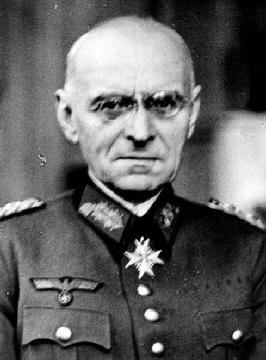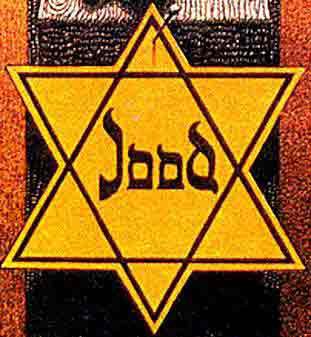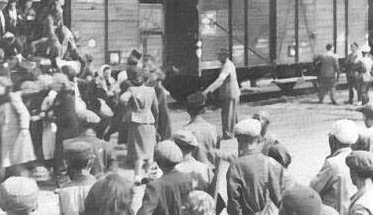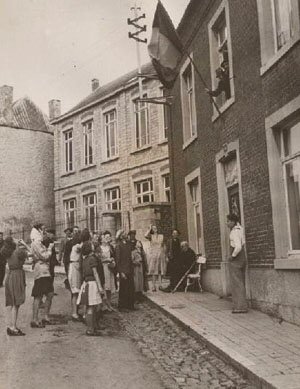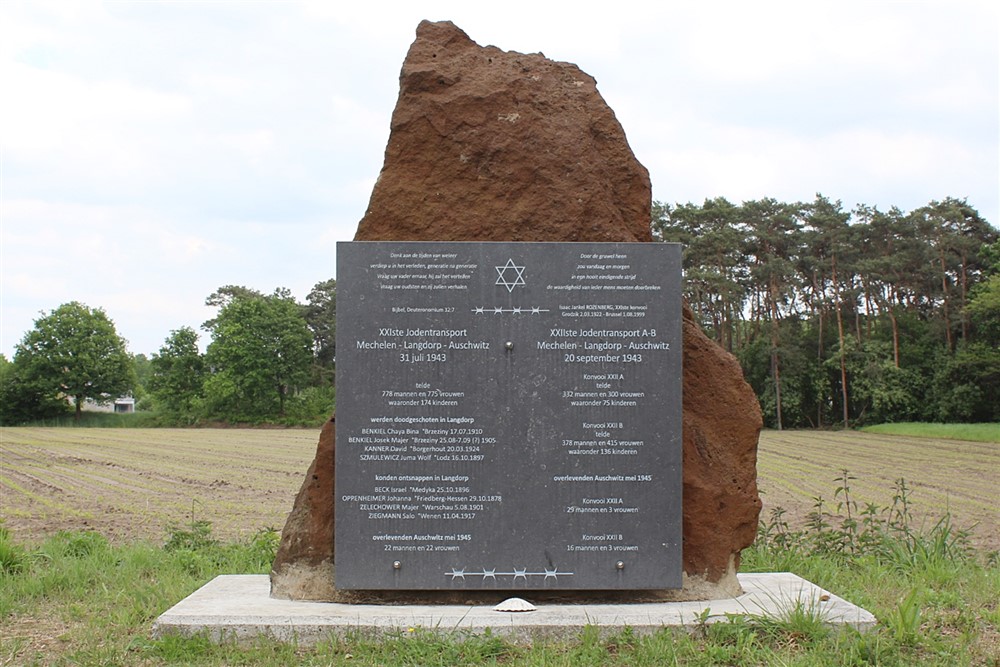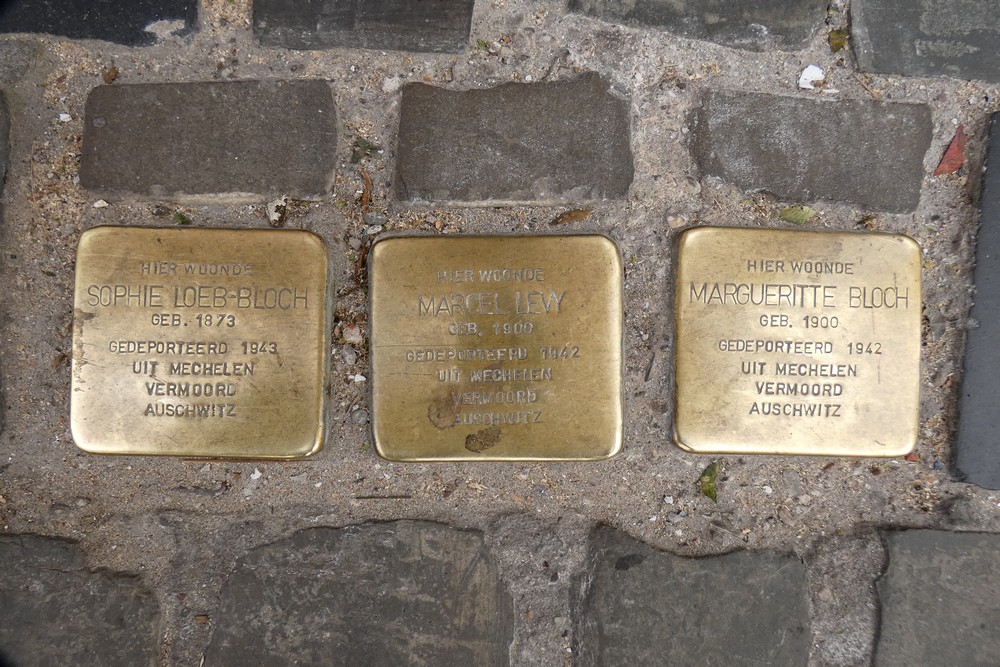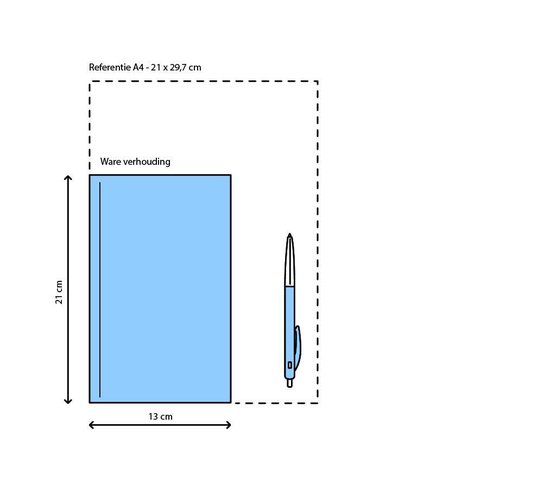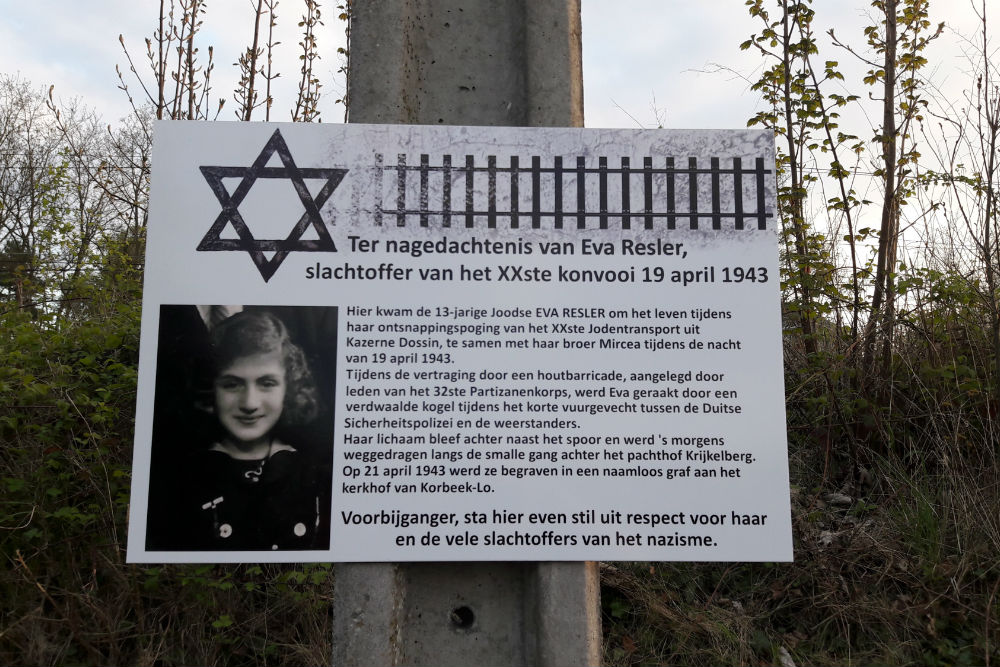Introduction
After the Germans conquered Belgium, the military administration gradually started pursuing the same racial policy as in Nazi Germany. The SS-Sammellager Mecheln (‘Mechelen transit camp’), also known as the Dossinkazerne, played an important role in this policy. Before dealing with the history of this transit camp, we will first discuss the pursued racial policy in Belgium, as they cannot be separated from one another.
Definitielijst
- Nazi
- Abbreviation of a national socialist.
Images
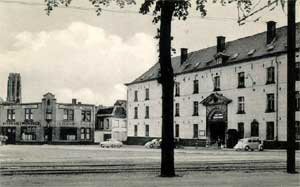 The SS-Sammellager Mechelen, situated on the border of the city. Source: Joods Museum voor deportatie en Verzet.
The SS-Sammellager Mechelen, situated on the border of the city. Source: Joods Museum voor deportatie en Verzet.The racial policy regarding Jews in Belgium
On May 10th, 1940, the Germans invaded Belgium. After the Belgian surrender, the occupiers installed a Militärverwaltung (‘military administration’) led by general Alexander von Falkenhausen. The anti-Jewish policy, as pursued in Germany, was now also enforced in Belgium.
The consequences were soon evident. Through eighteen anti-Jewish regulations between October 1940 and September 1942, Jews were slowly but surely excluded from the social-economic life. An important first step was the compulsory registration. All Jews above the age of fifteen were registered in a municipal register. Their identity cards were also marked with ‘Jood-Juif’. This way, 55.670 of the estimated 60.000 or 70.000 Jews living in Belgium were registered. A lot of them were people who fled from tsarist Russia in the twenties; 40% of them had Polish nationality and about 12.000 Jews were from Nazi Germany. Thus, they were mainly foreign refugees. Thanks to this list, the Germans had a clear idea of Jewish’ presence and activities in Belgium. On May 27th, 1942, a new regulation followed which required all Jews to wear the yellow Star of David. From 1941 onwards, a series of measures aimed at removing Jews from the economic life was issued. They were for example forced to make an inventory of their immovable property and they were banned from starting new companies. The most notable measure was of course the public marking of the Jewish character of their businesses and stores.
Pending a definitive decision with regard to the Jewish Question, Belgian Jews were forced to live in the cities Brussels, Antwerp, Liège and Charleroi. By the end of 1941, the ‘Association of Jews in Belgium (AJB)’, the so-called Judenrat (‘Jewish council’), was established and every Jew was obligated to join. The association served as an intermediary of the German orders to the Jewish community. The foundation fitted well within the framework of the Nazi tactics to have Jews participate in the persecution policy of the Nazis, just like in other countries.
With every measure, the occupiers moved conspicuously carefully. After all, they wanted to offend de Belgian governments and the public opinion as little as possible. For the daily rule of Belgium, the Militärverwaltung was largely dependent on the cooperation of the Belgian secretaries-general. Aside from one incident in Antwerp, the so-called Antwerp Kristallnacht (‘Crystal Night’) in April 1941, there was never a public display of physical violence against the Jews.
The year 1942 signified an important break in the Nazi politics with regard to the Jews. Take, for instance, the Wannsee Conference in January 1942. European Judaism had to be extirpated. On June 11th, 1942, in a Berlin meeting also attended by Adolf Eichmann, it was decided to start ‘evacuating’ Jews from the Netherlands, Belgium and France. Belgium had to ‘evacuate’ 20.000 Jews in the first year. In charge of this ‘evacuation’ was SS-Obersturmführer Kurt Asche, the Jewish Affairs consultant.
Within the framework of that Jew policy, Mechelen played an important part.
Definitielijst
- Jews
- Middle Eastern people with own religion that lived in Palestine. They distinguished themselves by their strong monotheism and the strict observance of the Law and tradition. During World War 2 the Jewish people were ruthlessly persecuted and annihilated by the German Nazis. . An estimated 6,000,000 Jews were exterminated.
- Judaism
- Monotheistic religion developed among the ancient Hebrews.
- Nazi
- Abbreviation of a national socialist.
- Wannsee Conference
- Conference at the Wannsee on 20 January 1942. The Nazi’s made final agreements about the extermination of Jews in Europe, the Final Solution (Ëndlösung).
Images
SS-Sammellager Mecheln
On May 17th, 1940, German troops entered Mechelen. The Catholic mayor Karel Dessain was the one to hand his city over to the Germans. About a year later, the 69-year-old Dessain was, however, forced to step down from office because of an ‘age regulation’ of the Germans. He was replaced by Camille Baeck, a councilman of the Flemish National Union (FNU) since 1938. On April 18th, 1941, the occupying government announced that “all activities of city councils were prohibited for the duration of the war”. The civil government was in control of the College van Burgemeester en Schepenen (‘the Bench of Mayor and Aldermen’). In Mechelen, this bench consisted of four members of the FNU and the two Catholics Neefs and Van de Werf, who had been aldermen since before the war. The ‘New Order’ dominated Mechelen and ruled the city for four years, until September 4th, 1944, when English tanks rolled into the city.
The Dossinkazerne in Mechelen played an important role during the Second World War. The “Kazerne Dossin de Saint-Georges”, named after lieutenant-general Baron Dossin de Saint-Georges (1854-1936), was built in 1756. Up until the Second World War, it functioned as a normal casern. In July 1942, the Dossinkazerne was given a change of use. The casern, from now on named SS-Sammellager Mecheln, became the central assembly point for the deportation of Jews from Belgium.
Mechelen was conveniently situated between Antwerp and Brussels, where most Jews in Belgium were accommodated. Moreover, the city had the Dossinkazerne at their disposal, which was perfect for the role of Sammellager. A maximum of a thousand people could be received and the casern commanded a connecting line between rail yard Mechelen-Neckerspoel and the tollhouse, situated beside the city pool and along the casern.
The transit camp was originally led by Philipp Schmitt. He was also commander of the Auffanglager (‘reception camp’) Breendonk nearby. In April 1943, he was succeeded by SS-Hauptscharführer Max Boden. Together with Rudolf Steckmann and Karl Mainzhausen, he was in charge of the Sammellager in Mechelen. Like in Breendonk, the Germans held the positions of officer while Flemish members of the SS took charge of surveillance.
Definitielijst
- Jews
- Middle Eastern people with own religion that lived in Palestine. They distinguished themselves by their strong monotheism and the strict observance of the Law and tradition. During World War 2 the Jewish people were ruthlessly persecuted and annihilated by the German Nazis. . An estimated 6,000,000 Jews were exterminated.
Images
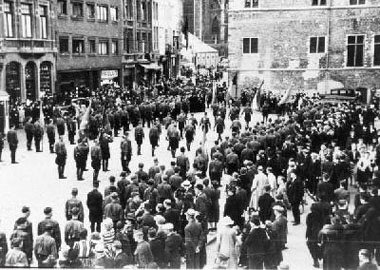 The collaborating group Dietsche Militanten hold a rally in Mechelen. Source: Archief Gazet van Antwerpen.
The collaborating group Dietsche Militanten hold a rally in Mechelen. Source: Archief Gazet van Antwerpen.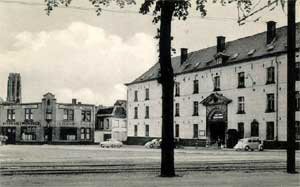 Entrance of the SS-Sammellager Mecheln. Source: Joods Museum voor Deportatie en Verzet.
Entrance of the SS-Sammellager Mecheln. Source: Joods Museum voor Deportatie en Verzet.Assembling in the Dossinkazerne
So as not to alarm the Jews and to let the assembling go smoothly, the “Association of Jews of Belgium” (AJB) had to distribute call-up notices, which, as was explained in the notices, had to do with a mandatory employment abroad. A list of materials the Jews had to bring along was added and this reinforced the impression that they would actually be put to work. Thousands of Jews then answered the call-up, also out of fear of possible reprisals.
The first Jews arrived in the Dossinkazerne on July 27th, 1942. During the following weeks, another three thousand Jews reported voluntarily. The first convoy left on August 4th, 1942, through Drancy (France) to Konzentrationslager (‘concentration camp’) Auschwitz. As mentioned before, the Jews got on the train voluntarily, convinced they would be employed elsewhere.
However, when it turned out that children would also be employed mandatorily, suspicions amongst the Jewish population grew. Almost six thousand Jews did not believe the story of mandatory employment and went into hiding. The transports were no longer filled and the Germans proceeded to harsher measures. In August and September, several big round-ups were held in Brussels and Antwerp.
The rounded up Jews were immediately transported in trucks to the Dossinkazerne, where armed SS members awaited them. Right away, the process of dehumanization, taking someone’s identity, a typical characteristic of the Nazi persecution system, started. Every Jew had to hand over all their identity papers: identity cards, membership cards of clubs or associations, even rail passes. Their details were recorded on a list, the infamous Transportliste (‘transport list’), but the deportees themselves were not allowed to own any form of identification. Also, the Jews and their luggage were searched to make sure they did not keep anything back. Anyone caught withholding goods was stripped off and beaten in front of their fellow sufferers. After registration and baggage check, the prisoners were given cardboard signs with their serial number for the convoy. They were to wear this around their neck at all times.
The Jews were divided into different groups: the ones who had to be deported immediately; the Jews from neutral countries or countries collaborating with Germany; the Entscheidungsfälle, or doubtful cases, like people from mixed blood (Mischlinge) or Jews married to non-Jews; and finally the politically dangerous Jews who were taken to prisons and prison camps. In the final stage of the camp’s existence, gypsies were also brought to the camp.
The entire registration procedure took up about three hours after which the prisoners were given a blanket, a plate and a spoon. Next, they were shown to their place to sleep. The sleeping quarters were about 21 by 7 meters large and they lodged approximately one hundred people every time. The rooms were rough and contained wooden bunk beds, two above each other. People slept on straw mattresses, which needed to be made perfectly. Because much was left to be desired regarding hygiene, all kinds of vermin, like lice, worms and flees, had free play. Scabies epidemics were frequent. It was not until the Germans feared the epidemics could catch to the city that the prisoners received treatment.
Daily life in the Sammellager strongly resembled life in a normal concentration camp with, for example, the regular rolls which were called. Prisoners had to get up at six and they had breakfast around seven o’clock. After this, the work was divided. At noon they ate some soup and at six o’clock in the evening soup was served again with some bread. So the prisoners received three meals a day, but the amounts were completely insufficient. Moreover, the food was of very poor quality. The prisoners ate offal and the bread was of abominable quality.
Though hitting and deliberately injuring prisoners was definitely not unusual in the Dossinkazerne, no systematic torture for information occurred.
Definitielijst
- concentration camp
- Closed camp where people are being held captive that are considered to be anti- social, enemies of the state, criminal or unwanted individuals. These groups mostly do not get a fair trial or are condemned to doing time in a camp.
- Jews
- Middle Eastern people with own religion that lived in Palestine. They distinguished themselves by their strong monotheism and the strict observance of the Law and tradition. During World War 2 the Jewish people were ruthlessly persecuted and annihilated by the German Nazis. . An estimated 6,000,000 Jews were exterminated.
- Nazi
- Abbreviation of a national socialist.
Images
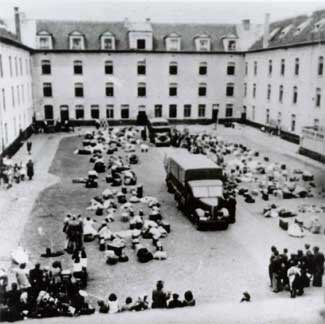 Arrested Jews were taken to the Dossin-kazerne in trucks. Source: Joods Museum voor Deportatie en Verzet.
Arrested Jews were taken to the Dossin-kazerne in trucks. Source: Joods Museum voor Deportatie en Verzet.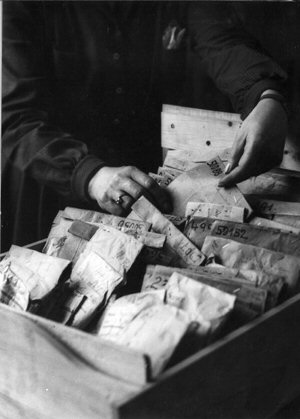 All the possessions of the Jews were classified and registered. Source: Archief Gazet van Antwerpen.
All the possessions of the Jews were classified and registered. Source: Archief Gazet van Antwerpen.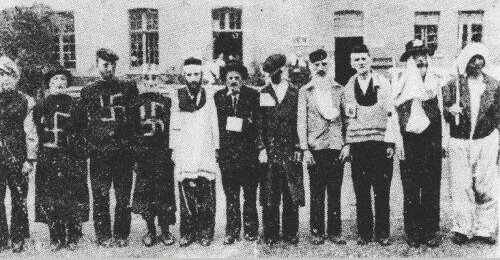 Jewish prisoners on the courtyard of the Sammellager. Source: Joods Museum voor Deportatie en Verzet.
Jewish prisoners on the courtyard of the Sammellager. Source: Joods Museum voor Deportatie en Verzet.The deportations
As mentioned before, over 55.000 Jews were registered. The Germans managed to round up 24.906 of them and deported them in 28 transports. Most of the transports left in 1942 and over 16.000 Jews were then deported. Still, this was considerably less than the demanded 20.000, but after a couple of transports the Jews began to realize that they were not being brought to normal working camps. In June 1943, Unser Kampf (‘Our Struggle’), an illegal magazine from Charleroi, published the report of two refugees from a working camp in Silesia. They reported on the incidents in Auschwitz ‘where Jews were burned alive’. Most people did not believe the story, though it did reinforce the Jews’ conviction that it was better to go into hiding. And they did, massively, which is why the Militärverwaltung could never meet the demanded quota.
The best known transport was the XXth convoy. Three young Belgian resistance fighters managed to stop the convoy, allowing dozens of people to escape. The final transport left on July 13th, 1944, but never reached its destination thanks to the fast advance of the Allies.
Despite the massive going into hiding by the Jews, the balance was extremely harsh for the Jewish population in Belgium: only 1.194 Jews survived the camps. For example, 82% of the fourth convoy was sent to the gas chambers immediately upon arrival in Auschwitz.
Not only Jews were the victim of Nazi persecutions: gypsies in Belgium were persecuted too. The gypsies remained out of harm’s way at first. Aside from the introduction of a gypsy card in December 1941, they were able to pursue their activities. The gypsies were only targeted in the round-ups from October 1943 onwards. In that period, 351 people were rounded up and taken to the Dossinkazerne. Strangely enough, no systematic persecution of gypsies occurred after that. On January 15th, 1944, the rounded up gypsies were taken to Auschwitz in a special Z-convoy. Most of them were children. Only thirteen people returned.
Definitielijst
- Jews
- Middle Eastern people with own religion that lived in Palestine. They distinguished themselves by their strong monotheism and the strict observance of the Law and tradition. During World War 2 the Jewish people were ruthlessly persecuted and annihilated by the German Nazis. . An estimated 6,000,000 Jews were exterminated.
- Nazi
- Abbreviation of a national socialist.
- resistance
- Resistance against the enemy. Often also with armed resources.
Images
The liberation and the museum
The liberation
Since D-Day, June 6th 1944, it was clear that the Germans were losing this war. The allied troops crossed Belgian borders in the beginning of September. For collaborating mayor Baeck and his FNU aldermen, this was the signal to flee the city. The German guards of the Dossinkazerne also bolted, causing about 500 Jews to be able to escape from the barracks in the night of September 4th.
Around noon that same September 4th, 1944, the first British tanks and Canadian infantrymen marched into the city. The recapture of Mechelen went quit smoothly, because most Germans had fled in the mean time.
Like Breendonk, the Dossinkazerne too experienced a dark piece of history after the liberation. The German military administration had fled and the Belgian government had not yet returned from exile. As a result, Belgium did not have an official government those first days of September. Like in many other places in Belgium, a true popular anger broke out, aimed at (suspected) collaborators. Many collaborators were arrested by the resistance and locked up in the Dossinkazerne. On September 16th, the former Sammellager even became an official internment camp where collaborators were locked up in anticipation of their trial.
The Jewish Museum of Deportation and Resistance
To honor many people who helped their Jewish fellow citizens go into hiding, to commemorate the part several hundred Belgian Jews played in the resistance, but especially to remember the horrors of the Shoah, the Flemish Community, the Antwerp province, the city Mechelen and the King Baudouin Foundation, together with the Jewish community of Belgium, decided to set up a permanent museum in a wing of the former “Kazerne Dossin de Saint-Georges” in the beginning of the nineties.
On September 20th, 1992, the first stone of the museum was laid by minister-president of the Flemish Community Luc Van den Brande, in the presence of the delegate of the king, the governor of the Antwerp province and the mayor of Mechelen. Together with these authorities, the Jewish Community of Belgium wanted to make this museum an educational tool and a memorial, so the tragic events of 1939-1945 would never be forgotten and to prevent something like that from ever happening again. On May 7th, 1995, the museum was inaugurated by king Albert II.
The Jewish Museum of Deportation and Resistance is one of the museums in Europe which shows the tragedy Jews suffered during the Second World War in the actual historic place where it happened. A historic place which itself served as a waiting room for the extirpation of the Jewish people.
In the museum, several subjects are treated, for instance: the murder of nearly half of the European Jews during the Second World War, the resistance of the Jews who were able to escape deportation, and the cooperation of a large section of the Belgian population, which helped many escape from the Nazis and their supporters.
Definitielijst
- D-Day
- The day of the long awaited invasion of western Europe in Normandy, France, 6 June 1944. After a long campaign of deception the allies attacked the coast of Normandy on five beaches to begin their march on Nazi Germany. Often explained as Decision Day, though this is entirely correct. The D stands for Day as generally used in military language. In this case it means an operation beginning on day D at hour H. Hence “Jour J“ in French.
- Jews
- Middle Eastern people with own religion that lived in Palestine. They distinguished themselves by their strong monotheism and the strict observance of the Law and tradition. During World War 2 the Jewish people were ruthlessly persecuted and annihilated by the German Nazis. . An estimated 6,000,000 Jews were exterminated.
- resistance
- Resistance against the enemy. Often also with armed resources.
Images
Information
- Article by:
- Gerd Van der Auwera
- Translated by:
- Kim van Dijk
- Published on:
- 10-02-2013
- Last edit on:
- 02-05-2020
- Feedback?
- Send it!
Related sights
Related books
Sources
- ABICHT, L., De joden van België, Amsterdam-Antwerpen, 1994.
- SAERENS, L., Vreemdelingen in een wereldstad. Een geschiedenis van Antwerpen en zijn joodse bevolking (1880-1944), Tielt, 2000.
- STEINBERG, M., 1942. Les cent jours de la déportation des juifs de Belgique, Brussel, 1984.
- STEINBERG, M., L’étoile et le fusil. La traque des juifs (1942-1944), Brussel, 1986.
- TEITELBAUM-HIRSCH, V., Tranen onder het masker. Ondergedoken kinderen, Antwerpen, 1994.
- VAN DOORSLAER, R, Kinderen van het getto, Antwerpen, 1985.
